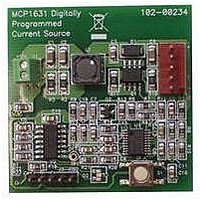MCP1631RD-MCC1 Microchip Technology, MCP1631RD-MCC1 Datasheet - Page 43

MCP1631RD-MCC1
Manufacturer Part Number
MCP1631RD-MCC1
Description
REFERENCE DESIGN FOR MCP1631HV
Manufacturer
Microchip Technology
Type
Battery Managementr
Datasheets
1.MCP1631VHVT-330EST.pdf
(34 pages)
2.MCP1631HV-330EST.pdf
(54 pages)
3.MCP1631RD-MCC2.pdf
(20 pages)
4.MCP1631RD-MCC2.pdf
(328 pages)
5.MCP1631RD-MCC1.pdf
(28 pages)
Specifications of MCP1631RD-MCC1
Main Purpose
Power Management, Battery Charger
Embedded
Yes, MCU, 8-Bit
Utilized Ic / Part
MCP1631HV, PIC16F883
Primary Attributes
1 ~ 2 Cell- Li-Ion, 1 ~ 4 Cell- NiCd/NiMH
Secondary Attributes
Status LEDs
Supported Devices
MCP1631HV, PIC16F883 Device Type
Tool / Board Applications
Power Management-Battery Management
Development Tool Type
Reference Design
Input Voltage
5.5 V to 16 V
Product
Power Management Modules
Mcu Supported Families
MCP1631HV/PIC16F883 Family
Silicon Manufacturer
Microchip
Silicon Core Number
MCP1631HV
Kit Application Type
Reference Design
Application Sub Type
Battery Charger
Kit Contents
Board Only
Lead Free Status / RoHS Status
Lead free / RoHS Compliant
For Use With/related Products
MCP1631HV, PIC16F883
Lead Free Status / RoHS Status
Lead free / RoHS Compliant
- MCP1631VHVT-330EST PDF datasheet
- MCP1631HV-330EST PDF datasheet #2
- MCP1631RD-MCC2 PDF datasheet #3
- MCP1631RD-MCC2 PDF datasheet #4
- MCP1631RD-MCC1 PDF datasheet #5
- Current page: 43 of 328
- Download datasheet (6Mb)
3.2.2
The Ultra Low-Power Wake-up (ULPWU) on RA0 allows
a slow falling voltage to generate an interrupt-on-change
on RA0 without excess current consumption. The mode
is selected by setting the ULPWUE bit of the PCON
register. This enables a small current sink, which can be
used to discharge a capacitor on RA0.
Follow these steps to use this feature:
a)
b)
c)
d)
e)
When the voltage on RA0 drops below V
will be generated which will cause the device to
wake-up and execute the next instruction. If the GIE bit
of the INTCON register is set, the device will then call
the interrupt vector (0004h).
This feature provides a low-power technique for
periodically waking up the device from Sleep. The
time-out is dependent on the discharge time of the RC
circuit on RA0. See Example 3-2 for initializing the
Ultra Low-Power Wake-up module.
© 2009 Microchip Technology Inc.
Charge the capacitor on RA0 by configuring the
RA0 pin to output (= 1).
Configure RA0 as an input.
Set the ULPWUIE bit of the PIE2 register to
enable interrupt.
Set the ULPWUE bit of the PCON register to
begin the capacitor discharge.
Execute a SLEEP instruction.
ULTRA LOW-POWER WAKE-UP
IL
, an interrupt
PIC16F882/883/884/886/887
A series resistor between RA0 and the external
capacitor provides overcurrent protection for the
RA0/AN0/ULPWU/C12IN0- pin and can allow for
software calibration of the time-out (see Figure 3-1). A
timer can be used to measure the charge time and
discharge time of the capacitor. The charge time can
then be adjusted to provide the desired interrupt delay.
This technique will compensate for the affects of
temperature, voltage and component accuracy. The
Ultra Low-Power Wake-up peripheral can also be
configured as a simple Programmable Low Voltage
Detect or temperature sensor.
EXAMPLE 3-2:
BANKSEL PORTA
BSF
BANKSEL ANSEL
BCF
BANKSEL TRISA
BCF
CALL
BANKSEL PIR2
BCF
BANKSEL PCON
BSF
BSF
BSF
MOVLW
MOVWF
SLEEP
NOP
Note:
PORTA,0
ANSEL,0
TRISA,0
CapDelay
PIR2,ULPWUIF
PCON,ULPWUE
TRISA,0
PIE2, ULPWUIE
B’11000000’
INTCON
For more information, refer to AN879,
“Using the Microchip Ultra Low-Power
Wake-up
(DS00879).
ULTRA LOW-POWER
WAKE-UP INITIALIZATION
Module”
;
;Set RA0 data latch
;
;RA0 to digital I/O
;
;Output high to
;charge capacitor
;
;Clear flag
;Enable ULP Wake-up
;RA0 to input
;Enable interrupt
;Enable peripheral
;interrupt
;Wait for IOC
;
Application
DS41291F-page 41
Note
Related parts for MCP1631RD-MCC1
Image
Part Number
Description
Manufacturer
Datasheet
Request
R

Part Number:
Description:
REFERENCE DESIGN MCP1631HV
Manufacturer:
Microchip Technology
Datasheet:

Part Number:
Description:
REF DES BATT CHARG OR LED DRIVER
Manufacturer:
Microchip Technology
Datasheet:

Part Number:
Description:
Manufacturer:
Microchip Technology Inc.
Datasheet:

Part Number:
Description:
Manufacturer:
Microchip Technology Inc.
Datasheet:

Part Number:
Description:
Manufacturer:
Microchip Technology Inc.
Datasheet:

Part Number:
Description:
Manufacturer:
Microchip Technology Inc.
Datasheet:

Part Number:
Description:
Manufacturer:
Microchip Technology Inc.
Datasheet:

Part Number:
Description:
Manufacturer:
Microchip Technology Inc.
Datasheet:

Part Number:
Description:
Manufacturer:
Microchip Technology Inc.
Datasheet:

Part Number:
Description:
Manufacturer:
Microchip Technology Inc.
Datasheet:










